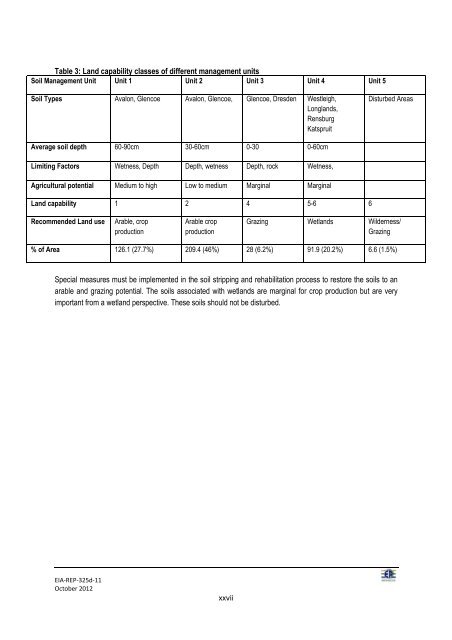EIA-REP-325d-12 _BB_ - 201.09.14.pdf - SAHRA
EIA-REP-325d-12 _BB_ - 201.09.14.pdf - SAHRA
EIA-REP-325d-12 _BB_ - 201.09.14.pdf - SAHRA
You also want an ePaper? Increase the reach of your titles
YUMPU automatically turns print PDFs into web optimized ePapers that Google loves.
Table 3: Land capability classes of different management units<br />
Soil Management Unit Unit 1 Unit 2 Unit 3 Unit 4 Unit 5<br />
Soil Types Avalon, Glencoe Avalon, Glencoe, Glencoe, Dresden Westleigh,<br />
Longlands,<br />
Rensburg<br />
Katspruit<br />
Average soil depth 60-90cm 30-60cm 0-30 0-60cm<br />
Limiting Factors Wetness, Depth Depth, wetness Depth, rock Wetness,<br />
Agricultural potential Medium to high Low to medium Marginal Marginal<br />
Land capability 1 2 4 5-6 6<br />
Recommended Land use Arable, crop<br />
production<br />
<strong>EIA</strong>-<strong>REP</strong>-<strong>325d</strong>-11<br />
October 20<strong>12</strong><br />
Arable crop<br />
production<br />
xxvii<br />
Disturbed Areas<br />
Grazing Wetlands Wilderness/<br />
Grazing<br />
% of Area <strong>12</strong>6.1 (27.7%) 209.4 (46%) 28 (6.2%) 91.9 (20.2%) 6.6 (1.5%)<br />
Special measures must be implemented in the soil stripping and rehabilitation process to restore the soils to an<br />
arable and grazing potential. The soils associated with wetlands are marginal for crop production but are very<br />
important from a wetland perspective. These soils should not be disturbed.

















